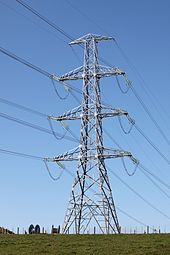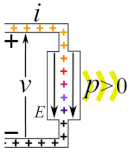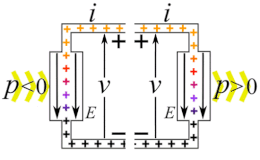Electric power
| Power | |
|---|---|
Common symbols | ℘ or P |
SI unit | watt (W) |
| In SI base units | kg⋅m2⋅s−3 |
Derivations from other quantities | |
| Dimension | |

Electric power is the rate of transfer of
. Standard prefixes apply to watts as with other SI units: thousands, millions and billions of watts are called kilowatts, megawatts and gigawatts respectively.In common parlance, electric power is the production and delivery of electrical energy, an essential public utility in much of the world. Electric power is usually produced by electric generators, but can also be supplied by sources such as electric batteries. It is usually supplied to businesses and homes (as domestic mains electricity) by the electric power industry through an electrical grid.
Electric power can be delivered over long distances by
Definition
Electric power, like
- W is work in joules
- t is time in seconds
- Q is electric charge in coulombs
- V is electric potential or voltage in volts
- I is electric current in amperes
I.e.,
- watts = volts times amps.
Explanation

Electric power is transformed to other forms of energy when

Active devices (power sources)
If
Passive devices (loads)
If

Passive sign convention
Since electric power can flow either into or out of a component, a convention is needed for which direction represents positive power flow. Electric power flowing out of a circuit into a component is arbitrarily defined to have a positive sign, while power flowing into a circuit from a component is defined to have a negative sign. Thus passive components have positive power consumption, while power sources have negative power consumption. This is called the passive sign convention.
Resistive circuits
In the case of
Alternating current without harmonics
In
- Vp is the peak voltage in volts
- Ip is the peak current in amperes
- Vrms is the root-mean-squarevoltage in volts
- Irms is the root-mean-squarecurrent in amperes
- θ = θv − θi is the phase angle by which the voltage sine wave leads the current sine wave, or equivalently the phase angle by which the current sine wave lags the voltage sine wave

The relationship between real power, reactive power and apparent power can be expressed by representing the quantities as vectors. Real power is represented as a horizontal vector and reactive power is represented as a vertical vector. The apparent power vector is the hypotenuse of a right triangle formed by connecting the real and reactive power vectors. This representation is often called the power triangle. Using the
Real and reactive powers can also be calculated directly from the apparent power, when the current and voltage are both sinusoids with a known phase angle θ between them:
The ratio of real power to apparent power is called power factor and is a number always between −1 and 1. Where the currents and voltages have non-sinusoidal forms, power factor is generalized to include the effects of distortion.
Electromagnetic fields
Electrical energy flows wherever electric and magnetic fields exist together and fluctuate in the same place. The simplest example of this is in electrical circuits, as the preceding section showed. In the general case, however, the simple equation P = IV may be replaced by a more complex calculation. The closed
The result is a scalar since it is the surface integral of the Poynting vector.
Production
Generation
2021
The fundamental principles of much electricity generation were discovered during the 1820s and early 1830s by the British scientist Michael Faraday. His basic method is still used today: electric current is generated by the movement of a loop of wire, or disc of copper between the poles of a magnet.
For electric utilities, it is the first process in the delivery of electricity to consumers. The other processes, electricity transmission, distribution, and electrical energy storage and recovery using pumped-storage methods are normally carried out by the electric power industry.
Electricity is mostly generated at a
A
Electric power industry
The electric power industry provides the production and delivery of power, in sufficient quantities to areas that need
Uses
Electric power, produced from central generating stations and distributed over an electrical transmission grid, is widely used in industrial, commercial, and consumer applications. A country's per capita electric power consumption correlates with its industrial development. [10] Electric motors power manufacturing machinery and propel subways and railway trains. Electric lighting is the most important form of artificial light. Electrical energy is used directly in processes such as extraction of aluminum from its ores and in production of steel in electric arc furnaces. Reliable electric power is essential to telecommunications and broadcasting. Electric power is used to provide air conditioning in hot climates, and in some places, electric power is an economically competitive energy source for building space heating. The use of electric power for pumping water ranges from individual household wells to irrigation and energy storage projects.
See also
- EGRID
- Electric energy consumption
- Electric power system
- High-voltage cable
- Power engineering
- Rural electrification
References
- ^
Smith, Clare (2001). Environmental Physics. London: ISBN 0-415-20191-8.
- ^ ISBN 978-1-119-23538-5.
- ISBN 978-8-48-322795-4.
- ISBN 978-0-7381-6058-0.
- ISBN 978-0-07-338066-7.
- ^ "Yearly electricity data". ember-climate.org. 6 Dec 2023. Retrieved 23 Dec 2023.
- ^ "battery" (def. 4b), Merriam-Webster Online Dictionary (2009). Retrieved 25 May 2009.
- ^ Power Shift: DFJ on the lookout for more power source investments Archived 2005-12-01 at the Wayback Machine. Draper Fisher Jurvetson. Retrieved 20 November 2005.
- ^ The Opportunity of Energy Group-Buying Archived 2017-05-25 at the Wayback Machine EnPowered, April 18, 2016,
- ISBN 1447150341, p. 8.
Bibliography
- Reports on August 2003 Blackout, North American Electric Reliability Council website
- Croft, Terrell; Summers, Wilford I. (1987). American Electricians' Handbook (Eleventh ed.). New York: ISBN 0-07-013932-6.
- ISBN 0-07-020974-X.









